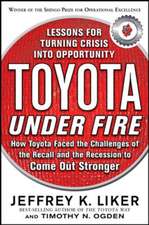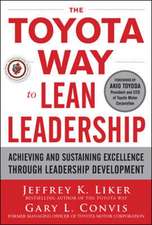Everyone's Problem Solving Handbook: Step-by-Step Solutions for Quality Improvement
Autor Michael R. Kellyen Limba Engleză Paperback – 31 ian 1992
Identify the problem: Clearly state what needs improvement.
Analyze: Determine what causes the problem to occur.
- Evaluate Alternatives: Identify and select actions to reduce or eliminate the problem.
- Test Implement: Implement these actions on a trial basis to determine their effectiveness.
- Standardize: Ensure that useful actions are preserved.
| Toate formatele și edițiile | Preț | Express |
|---|---|---|
| Paperback (1) | 279.56 lei 6-8 săpt. | |
| Taylor & Francis – 31 ian 1992 | 279.56 lei 6-8 săpt. | |
| Hardback (1) | 986.91 lei 6-8 săpt. | |
| Taylor & Francis – 14 sep 2017 | 986.91 lei 6-8 săpt. |
Preț: 279.56 lei
Nou
Puncte Express: 419
Preț estimativ în valută:
53.50€ • 55.65$ • 44.17£
53.50€ • 55.65$ • 44.17£
Carte tipărită la comandă
Livrare economică 14-28 aprilie
Preluare comenzi: 021 569.72.76
Specificații
ISBN-13: 9780527916527
ISBN-10: 0527916528
Pagini: 176
Dimensiuni: 210 x 280 x 10 mm
Greutate: 0.33 kg
Ediția:Third
Editura: Taylor & Francis
Colecția Productivity Press
Locul publicării:Oxford, United Kingdom
ISBN-10: 0527916528
Pagini: 176
Dimensiuni: 210 x 280 x 10 mm
Greutate: 0.33 kg
Ediția:Third
Editura: Taylor & Francis
Colecția Productivity Press
Locul publicării:Oxford, United Kingdom
Public țintă
Professional Practice & DevelopmentCuprins
Preface Chapter One: A New Way of Thinking Chapter Two: A Systematic Approach Chapter Three: Tools for Quality Improvement Chapter Four: Applying the Tools for Quality Improvement Glossary Bibliography Index
Descriere
The author covers 14 tools to help you find the information you need. He shows you how these tools can be combined with a set of simple problem-solving steps that can act as a powerful change agent to cope with process problems. With the Five-Step Problem-Solving Process, the first two steps are to identify the problem and then clearly state what needs improvement. Then after determining what causes the problem, one should evaluate alternatives, identifying the actions needed to reduce or eliminate the problem. Next one implements these actions on a trial basis to determine their effectiveness, and then standardizes the working ones to ensure that useful actions are preserved.











